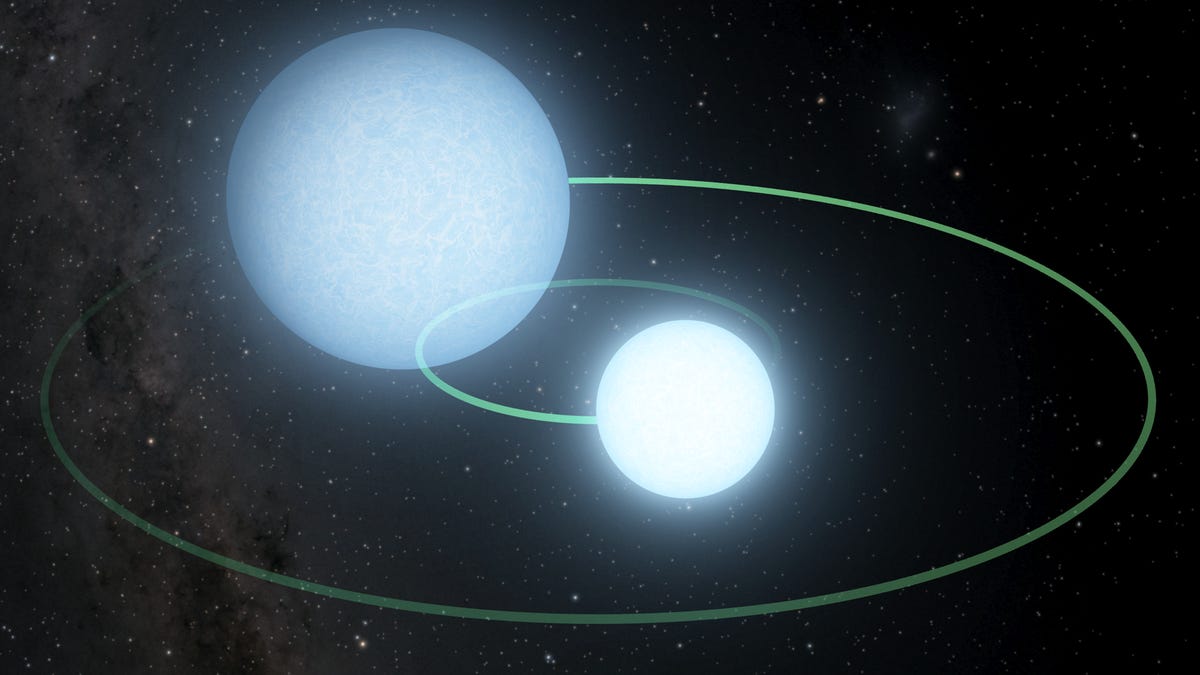Astronomers discover two ferociously fast stars locked in a death spiral
The fastest eclipsing binary system ever discovered features two white dwarfs zooming around each other once every seven minutes.

Artist's impression of the pair of white dwarfs, ZTF J1530+5027.
At CNET, we're big fans of seeing cosmic phenomena locked in dizzying dances of doom. When two huge objects become bound by each other's gravity, they can be locked into a spiral, circling each other until they merge or die. Astronomers have spotted another such system, this time featuring two "dead stars" -- white dwarfs -- zipping around each other once every seven minutes.
The incredibly fast orbits make this the fastest eclipsing binary system yet recorded.
The discovery, dubbed ZTF J1539+5027 and published Wednesday in the journal Nature, was made by researchers using Caltech's Zwicky Transient Facility (ZTF), a whole sky survey designed to locate objects that rapidly change in brightness. Searching in the Boötes constellation, researchers spotted this particular pair of dead stars around 8,000 light-years away. The two white dwarfs are so close to each other they are practically spooning, with only 80,000 kilometers (about 49,700 miles) between them, and they're travelling at hundreds of kilometers per second.
Astronomers officially identify this system as an "eclipsing binary" because, from our point of view, one of the stars consistently passes in front of the other. Combined, two stars have a mass similar to that of our sun, but they aren't twins. One of the white dwarfs is a little bit smaller and a little dimmer.
"As the dimmer star passes in front of the brighter one, it blocks most of the light, resulting in the seven-minute blinking pattern we see in the ZTF data," said Kevin Burdge, lead author on the study and a Ph.D. candidate in physics at Caltech. "We rarely catch these systems as they are still merging like this one."
One of the dwarfs -- the more compact one -- is incredibly hot. Burdge suggests it may have been heating up as it fed on its dancing partner like some sort of creepy space vampire, draining material from its surface. However, so far, he hasn't seen any evidence of such an event. On the flip side, the research team also thinks the cooler dwarf (as in colder, not more trendy) shouldn't be so cold. Burdge calls that another "puzzle."
An artist's animation of the eclipsing binary.
However, there are a few things the team does know. The rare find is important because astronomers know the system emits gravitational waves, faint ripples in spacetime that have only recently been discovered. The dead, Earth-size stars are super dense, and their movement through spacetime as they spin around each other causes invisible waves to emanate outward, travelling through the cosmos.
We can't detect them from this pair yet, Burdge noted, because Earth is too noisy to see the signal generated by the duo. It's good news that they will keep spinning around each other for another 100,000 years -- giving us a chance to detect their gravitational waves at some point in the next 15 years when the European Space Agency's Laser Interferometer Space Antenna (LISA) comes online. Burdge is just trying to get ahead of the game.
"The overall intent of the project is to identify as many LISA sources as possible before LISA comes online," he said. "The earlier you catch these sources, the longer you can monitor them for orbital decay."
That gives researchers time to measure the orbital decay that can determine how far away the binary is.
Set to launch in 2034, LISA will hunt for faint gravitational waves from orbit. The trio of satellites stationed in space, Burdge notes, will be complimentary to current gravitational wave detectors on Earth, such as the Laser Interferometer Gravitational-Wave Observatory (LIGO) in the US.
"LIGO can see things that LISA can't, and LISA can see some things that LIGO can't, and there are a handful of things that might switch from being visible in LISA to LIGO over time," he said.
Part of Burdge's work will look for similar events to ZTF J1539+5027 and help build a clearer understanding of a star's life, how white dwarfs come to be and how binary systems work.
"This system will stay interesting for the next 30 years, because as time goes on, we should be able to measure tidal effects in the orbital decay, and eventually get a LISA signal from it," said Burdge.
"It has already taught us a lot we didn't know before, created many new questions, and still has a lot more to teach us."
Originally published 10:00 a.m. PT
Updated 3:20 p.m. PT: Adds additional Burdge comment regarding LISA.

